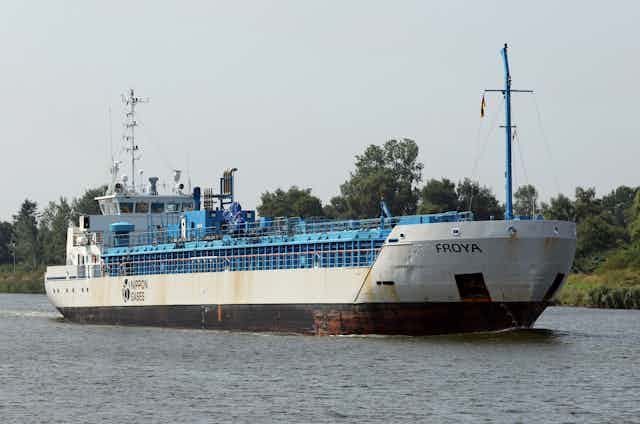Fossil fuel companies in Australia could ship their carbon dioxide (CO₂) waste overseas for disposal, under changes to the Environment Protection (Sea Dumping) Act 1981 introduced to parliament late last week.
During her second reading speech, Environment Minister Tanya Plibersek said:
Companies would be able to better plan for transboundary projects for carbon capture and storage into sub-seabed geological formations within a clear regulatory framework. Until then, this export activity is not permitted under the sea dumping act.
The Environment Protection (Sea Dumping) Amendment (Using New Technologies to Fight Climate Change) Bill 2023 will allow export of CO₂ for the purpose of “sequestration”, or storage under the sea. Companies, or research organisations, would need to first apply for an export permit.
The main difficulty with this plan is that offshore carbon capture and storage has not worked effectively in Australian waters.
If a permit is given for CO₂ waste to be exported to poorer countries, it’s unclear how these countries will acquire the capacity and knowledge to achieve successful carbon storage when wealthy fossil fuel companies operating in Australia could not.
No lack of storage capacity here
The stated objective of the amendment is to:
support countries without storage capacity to reduce their atmospheric emissions by allowing the export of carbon dioxide streams to countries with available sub-seabed geological storage formations.
But Australia appears to have a great deal of storage capacity, with conservative estimates putting the total at 740 billion tonnes.
In 2021, five areas for Offshore Greenhouse Gas Storage in Commonwealth waters were identified off the coast of Western Australia and the Northern Territory.
The real issue is not lack of storage capacity but rather, the fact offshore CO₂ injection is not working.
World’s biggest carbon capture and storage flop
In Australia the only operational offshore carbon capture and storage project is Chevron’s Gorgon Project on Barrow Island in Western Australia.
Onshore, the Santos Moomba carbon capture and storage project in South Australia will become operational in 2024. Like the Gorgon project, the Moomba project has made bold claims, stating it has capacity to store up to 1.7 million tonnes of CO₂ annually.
Chevron built the “world’s largest” system to extract CO₂ in gas from its offshore reservoirs and inject it deep under the island. The A$81 billion gas export plant was approved on the condition it could store CO₂ in offshore reservoirs and, at a minimum, inject 80% of the CO₂ from the gas produced.
But in the 12 months to June 2022 Chevron only injected 1.6 million tonnes of CO₂ into the underground reservoir and vented 3.4 million tonnes to the atmosphere.
In the six years since export of LNG commenced from the Gorgon Project, 20.4 million tonnes of CO₂ has been extracted but only 6.5 million tonnes has been stored under the island. This significant shortfall adds to global warming and impedes Australia’s ability to reach our legislated 2030 emissions cuts.
Transferring CO₂ to poorer countries is also bonus for fossil fuel companies like Chevron because from July 1, the reformed safeguard mechanism will make carbon capture and storage failures very expensive.
That’s because the new safeguard mechanism does not allow emission baselines to be as readily adjusted as used to be the case.
Fossil fuel companies will have to begin paying a lot more for emissions that are above their allocated baselines. For example, a report estimates Woodside and its partners will be subject to an additional cumulative liability of up to A$63 billion up to 2050 at the Burrup Hub LNG export project under the new safeguard mechanism reforms. Exporting CO₂ from failed carbon capture and storage sites will allow fossil fuel companies to avoid these costs.
London calling
The existing anti-dumping legislation and the proposed change stem from international agreement.
The Convention on the Prevention of Marine Pollution by Dumping of Wastes and Other Matter, 1972 (London Convention) was the first international agreement designed to protect the marine environment from sea dumping.
Sea dumping refers to the deliberate disposal of wastes or other matter from vessels, aircraft, platforms or man-made structures into the sea. It does not include material released directly into the sea from a land source or operational discharges from ships.
The London Convention sets up a framework which prohibited sea dumping and which required parties to apply for a special permit for approved materials to be dumped.
The subsequent London Protocol of 2006 took a more restrictive approach. The Protocol prohibited all sea dumping except for identified wastes such as dredged material, sewage sludge, and fish waste. These listed wastes could be dumped if a permit was approved but approval could not be given if it was reasonably likely to cause harm.
Amendments adopted to the London Protocol in 2009 and 2013, yet to be ratified, allowed for the export of CO₂ streams to countries with suitable offshore storage sites, provided an agreement or arrangement has been entered into between the countries concerned.
Australia intends to ratify the 2009 and 2013 amendments, and the amendments to the Sea Dumping Act represent the first stage in this process. The Department of Climate Change, Energy, the Environment and Water (DCCEW) has indicated Australia will apply a “precautionary approach” in the assessment of these permits.
Shifting the problem elsewhere
It’s argued that exporting CO₂ to storage sites overseas will provide significant environmental benefits within a decarbonising economy. The Australian research and industry collaboration CO2CRC considers such transboundary exportation “safe, reliable, necessary and urgent”.
But this is all premised on the assumption carbon capture and storage is effective and operational. The Australian experience to-date shows it is not. So the only apparent benefit of exporting CO₂ overseas lies in the fact it shifts the problem of escalating emissions out of the country.
Correction: this article originally stated Moomba was in the NT.

